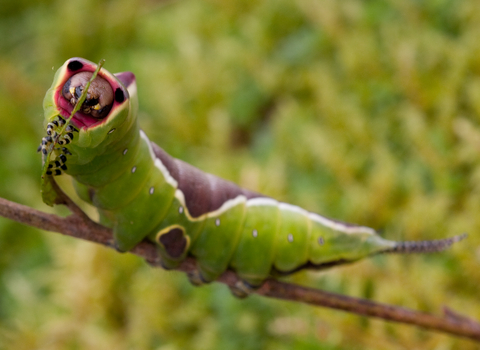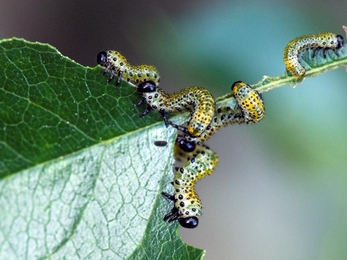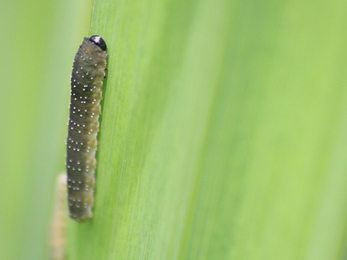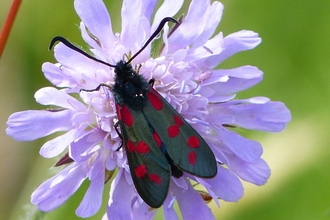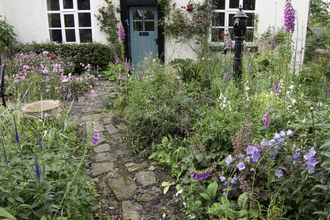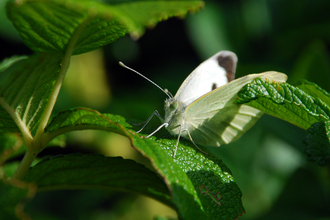A caterpillar is the larval stage of a moth or butterfly. It is the second part of their four-stage life cycle (egg, larva, pupa, adult). Caterpillars have long, worm-like bodies with six true legs. They can also have a variable number of stumpy false legs (called prolegs), which help them to move and cling to things.
Caterpillars can change dramatically from when they first hatch to when they're ready to pupate. Some can increase their body mass 10,000-fold in just a few weeks! Many look very different as they grow, so we've described the larger stages of the caterpillar's growth, when they're often more obvious.
Some are easily spotted on their favourite food plants. Here are some of the species you're likely to see.
Drinker moth
When & where: August to June. A variety of habitats including gardens, but especially damp grassland, marshes and boggy areas.
Description: Up to 7 cm long. Dark and covered with brown hairs and golden speckles. A row of white hairs runs down each side of the body.
Females drinker moths lay eggs in small clusters on reed and grass stems, which hatch in just over a week. They spend the winter as a small caterpillar, tucked away in sheltered spots low down in the vegetation. They emerge again in spring to fatten up, when they're often seen basking on low vegetation. When they're large enough, they pupate inside a papery cocoon formed on a grass or reed stem.
Fox moth
When & where: June to April, but they are most obvious in spring when they'll be basking in the sun. Often found in heathland and coastal grassland.
Description: Up to 7 cm long. Hairy, with long dark hairs on the sides of the body and shorter orange hairs on top. Young caterpillars are dark with orange bands.
The adult female moths lay batches of eggs on grass stems, or on the leaves of plants the caterpillars will eat - they're not fussy and will feed on bramble, heathers, bilberry and more. You can often see the caterpillars in summer and early autumn, feasting on foodplants or crawling across footpaths as they search for their next meal. They spend the winter as a fully-grown caterpillar, tucked under fallen leaves or moss, before emerging again in early spring. They don't feed in spring, but are often seen soaking up some sun. They then form a cocoon low down in vegetation, where they pupate and become adult moths, which take to the wing in May and June.
Garden tiger moth
When & where: August to June. A wide range of habitats including gardens.
Description: Up to 6 cm long. An extremely hairy caterpillar, known as the "woolly bear". Mostly black and ginger with longer white hairs that are highly irritating, they feed on stinging nettles, dock leaves and many garden plants.
Elephant hawk-moth
When & where: June to September. They're found in a variety of habitats, and are often spotted in gardens on fuschia plants. Often where rosebay willowherb is found as this is one of it's favourite plants to eat. They will also eat Himalayan balsam and bedstraw.
Description: Up to 8.5 cm long. A chunky green or brown caterpillar, with several eyespots at the front end and a spiky 'tail' at the rear. When disturbed, they swell up to show these spots and scare off predators. They overwinter as chrysalides, hidden among low vegetation or in the soil.
Puss moth
When & where: June to September. Widespread in a variety of habitats, including parks, gardens and wetlands. They're often found feeding on poplars and willows.
Description: Recently hatched caterpillars are tiny and black, with two long, whip-like tails. Older caterpillars are plump and green, with a dark, white-edged 'saddle'. The head is surrounded by a pink patch, with false eyes making it look like a giant face. They still have two thin striped tails, and when alarmed thing red tails extend from these are swish around. If the tails don't work they have a secret weapon - they can squirt formic acid at their attacker.
When they're fully fed, they turn a purplish colour and leave their food plant to search for a place to pupate. They use their strong jaws to chew up bark, mixing it with silk to create a tough cocoon on a tree trunk. They spend the winter as a pupa, inside their cocoon, before emerging in spring - though they sometimes remain in this state for two winters.
Privet hawk-moth
When & where: July to September. Widespread in southern England and Wales, they're found in a variety of habitats, including gardens.
Description: Up to 8.5cm long. Green and chunky, with purple and white stripes on the body and a black and yellow horn on the rear. They feed mainly on privet, but also on ash and lilac leaves. As they mature, they turn pinkish and burrow deep into soil in order to pupate, hatching out the following summer.
Peacock butterfly
When & where: May-July. Common in a range of habitats where common nettle is present.
Description: Up to 4.5 cm. Black with black spines and small white dots. Found in communal webs on common nettles.
Vapourer moth
When & where: May to September. Commonly found in a variety of habitats including woodland, parks and gardens.
Description: A funky-looking grey and black caterpillar, with large tufts of hair, including a mohawk of yellow tufts on the back. Large caterpillars can often be spotted in late summer on a range of shrubs and trees.
Pale tussock moth
When & where: June-October. Found on a wide variety of deciduous trees and other plants, including bramble.
Description: A striking bright green caterpillar, with black bands between its body segments, yellow/whitish hairs, a row of yellow tufts on top and a red tuft at the rear. The adults emerge in spring and can be seen flying between May and June. They're often attracted to lights, with males sometimes turning up in large numbers.
The bizarre-looking caterpillars feed on a host of broadleaf trees and shrubs, including blackthorn, hawthorns, oaks, hazel, crab apple, and birches. They can often be seen wandering across the ground in autumn as they get ready to pupate, spending winter as a pupa in a hairy silk cocoon, tucked amongst the leaves of one of their foodplants, or down in the leaf litter below.
Knot grass moth
When & where: June and September, though caterpillars of the southern second generation are around in September and October. Grasslands, wetlands, heathlands, open woodlands, and coastal habitats.
Description: Black with brown hairs. Row of alternating red spots and lines on top, with a line of white dashes either side. There is a row of spots and dashes on each side, and it rests with slight hunch in the back.
As the name suggests, the caterpillars will sometimes feed on knotgrass plants, though not exclusively. They enjoy a wide variety of woody and herbaceous plants, including broad-leaved dock, plantains, bramble, hawthorn, common sorrel, heather, and purple loosestrife. They spend the winter as a pupa, in a cocoon on the ground tucked away amongst leaf litter.
Cinnabar moth
When & where: July to September. Most commonly found on ragwort, their food plant, in grassy habitats.
Description: The caterpillars of this moth are distinctive, with black and yellow stripes - warning predators that they taste terrible. They spend the winter as cocoons on the ground before emerging as moths in the summer.
Mullein moth
When & where: April to July. Found in a range of open habitats, including gardens.
Description: Distinctive whitish caterpillars, with yellow splodges across the body and large black spots. They feed on mulleins, particularly great mullein, but will eat the leaves of other plants, including garden buddleias. They spend the winter as a pupa, in a strong cocoon in the ground. They have been known to spend up to five winters in this state before emerging.
Not a caterpillar!
Sawfly larvae
Sawflies are a group of flies, whose larvae look very similar to moth and butterfly caterpillars. The larvae are usually 1-4 cm long, but come in an impressive variety of colours. One way to spot a sawfly larva is to count the legs - they also have six true legs, but usually have six or more pairs of the stumpy 'prologs', whereas caterpillars have five or fewer.

